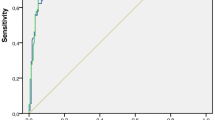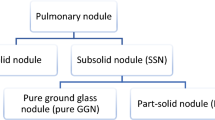Abstract
Purpose
18-fluorine fluorodeoxyglucose (18F-FDG) positron emission tomography–computed tomography (PET–CT) has an established role for the characterization of solitary pulmonary nodules (SPN). Visual assessment of nodule morphology, together with maximum standardized uptake value (SUVmax), is used to estimate likelihood of malignancy. We correlated SUVmax value with pathology of SPN and assessed diagnostic accuracy in differentiating malignant from benign nodule, using 2.5 as threshold SUVmax.
Methods
Retrospective review of PET–CT scans for SPN characterization between April 2008 and June 2011 was performed. Only cases with pathological verification were included.
Results
A total of 641 PET-CTs were performed for SPN characterization and staging; 186 patients (77 males, 109 females) with pathological confirmation were included, and 158 (85 %) nodules were malignant: adenocarcinomas (n = 66), squamous cell carcinomas (n = 40), and metastases (n = 20) were the commonest. 28 lesions (15 %) were benign, including granuloma/chronic inflammation (n = 8), infection (n = 7), and hamartomas (n = 5). Using cutoff SUVmax of 2.5, the accuracy of PET–CT in diagnosing malignant SPN is 81.2 %, with sensitivity 86.7 %, specificity 50 %, PPV 90.7 %, and NPV 40 %. The likelihood of malignancy increases with SUVmax. Nevertheless, even with SUVmax <2.5, there is a 62 % chance that a nodule is malignant.
Conclusions
Although PET–CT is useful in diagnostic workup of SPN, it cannot replace “gold standard” tissue diagnosis.
Similar content being viewed by others
References
Tan BB, Flaherty KR, Kazerooni EA, Iannettoni MD (2003) The solitary pulmonary nodule. Chest 123(1 Suppl):89S–96S
Gurney JW (1993) Determining the likelihood of malignancy in solitary pulmonary nodules with Bayesian analysis. Part I. theory. Radiology 186(2):405–413
Midthun DE, Swensen SJ, Jett JR (1993) Approach to the solitary pulmonary nodule. Mayo Clin Proc 68:378–385
Lillington GA, Caskey CI (1993) Evaluation and management of solitary and multiple pulmonary nodules. Clin Chest Med 14:111–119
Ferlay J, Parkin DM, Steliarova-Foucher E (2010) Estimates of cancer incidence and mortality in Europe in 2008. Eur J Cancer 46(4):765–781
Erasmus JJ, Connolly JE, McAdams HP, Roggli VL (2000) Solitary pulmonary nodules: part 1. Morphologic evaluation for differentiation of benign and malignant lesions. Radiographics 20:43–58
Swensen SJ, Viggiano RW, Midthun DE, Muller NL, Sherrick A, Yamashita K et al (2000) Lung nodule enhancement at CT: multicenter study. Radiology 214:73–80
Jeong YJ, Lee KS, Jeong SY, Chung MJ, Shim SS, Kim H et al (2005) Solitary pulmonary nodule: characterization with combined wash-in and wash-out features by dynamic multidetector CT enhancement study. Radiology 237:675–683
Lee KS, Yi CA, Jeong SY, Jeong YJ, Kim S, Chung MJ et al (2007) Solid or partly solid solitary pulmonary nodules: their characterisation using contrast wash-in and morphologic features at helical CT. Chest 131:1517–1526
Gould MK, Maclean CC, Kuschner WG, Rydzak CE, Owens DK (2001) Accuracy of positron emission tomography for diagnosis of pulmonary nodules and mass lesions: a meta-analysis. JAMA 285:914–924
Gould M, Fletcher J, Iannettoni MD (2007) Evaluation of patients with pulmonary nodules: when IS it lung cancer? ACCP evidence-based clinical practice guidelines (2nd edition). Chest 132:108S–130S
Lowe VJ, Hoffman JM, DeLong DM, Patz EF, Coleman RE (1994) Semiquantitative and visual analysis of FDG-PET images in pulmonary abnormalities. J Nuc Med 35(11):1771–1776
Al-Sugair A, Coleman RE (1998) Applications of PET in lung cancer. Semin Nucl Med 28(4):303–319
Basu S, Chryssikos T, Moghadam-Kia S, Zhuang H, Torigian DA, Alavi A (2009) Positron emission tomography as a diagnostic tool in infection: present role and future possibilities. Semin Nucl Med 39:36–51
Lowe VJ, Fletcher JW, Gobar L, Lawson M, Kirchner P, Valk P et al (1998) Prospective investigation of positron emission tomography in lung nodules. J Clin Oncol (16)3:1075-1084
Christensen JA, Nathan MA, Mullan BP, Hartman TE, Swensen SJ, Lowe VJ (2006) Characterisation of the solitary pulmonary nodule: 18F-FDG PET versus nodule-enhancement CT. Am J Roentgenol 187(5):1361–1367
Hashimoto Y, Tsujikawa T, Kondo C, Maki M, Momose M, Nagai A et al (2006) Accuracy of PET for diagnosis of solid pulmonary lesions with 18F-FDG uptake below the standardized uptake value of 2.5. J Nucl Med 47:426–431
MacMahon H, Austin JH, Gamsu G, Herold CJ, Jett JR, Naidich DP et al (2005) Guidelines for management of small pulmonary nodules detected on CT scans: a statement from the Fleischner Society. Radiology 237(2):395–400
Kim SK, Allen-Auerbach M, Goldin J, Fueger BJ, Dahlbom M, Brown M et al (2007) Accuracy of PET–CT in characterization of solitary pulmonary lesions. J Nucl Med 48(2):214–220
Yi CA, Lee KS, Kim BT, Choi JY, Kwon OJ, Kim H et al (2006) Tissue characterization of solitary pulmonary nodule: comparative study between helical dynamic CT and integrated PET/CT. J Nucl Med 47(3):443–450
Nguyen NC, Kaushik A, Wolverson MK, Osman MM (2011) Is there a common SUV threshold in oncological FDG PET/CT, at least for some common indications? A retrospective study. Acta Oncol 50(5):670–677
Gupta NC, Graber GM, Bishop HA (2000) Comparative efficacy of positron emission tomography with fluorodeoxyglucose in evaluation of small (<1 cm), intermediate (1–3 cm) and large (>3 cm) lymph node lesions. Chest 117(3):773–778
Rasey JS, Grierson JR, Wiens LW, Kolb PD, Schwartz JL (2002) Validation of FLT uptake as a measure of thymidine kinase-1 activity in A549 carcinoma cells. J Nucl Med 43(9):1210–1217
Bar-Shalom R, Valdivia AY, Blaufox MD (2000) PET imaging in oncology. Semin Nucl Med 30(3):150–185
de Geus-Oei LF, van Krieken JH, Aliredjo RP, Krabbe PF, Frielink C, Verhagen AF et al (2007) Biological correlates of FDG uptake in non-small cell lung cancer. Lung Cancer 55(1):79–87
Higashi K, Ueda Y, Seki H, Yuasa K, Oguchi M, Noguchi T et al (1998) Fluorine-18-FDG-PET imaging is negative in bronchioloalveolar lung carcinoma. J Nucl Med 39(6):1016–1020
Travis WD, Brambilla E, Noguchi M, Nicolson AG, Geisinger KR, Yatabe Y et al (2011) International Association for the Study of Lung Cancer/American Thoracic Society/European Respiratory Society International multidisciplinary classification of lung adenocarcinoma. J Thorac Oncol 6(2):244–285
Zhuang H, Pourdehnad M, Lambright ES et al (2001) Dual time point 18F-FDG PET imaging for differentiating malignant from inflammatory processes. J Nucl Med 42:1412–1417
Barger RL, Nandalur KR (2012) Diagnostic performance of dual-time 18F-FDG PET in the diagnosis of pulmonary nodules: a meta-analysis. Acad Radiol 19:153–158
Bryant AS, Cerfolio RJ (2006) The maximum standardized uptake values on integrated FDG-PET/CT is useful in differentiating benign from malignant pulmonary nodules. Ann Thorac Surg 82:1016–1020
Acknowledgments
Professor Alan Foulis and Dr. Elaine Macduff, both Consultant Pathologists in NHS Greater Glasgow and Clyde, for their advice on pathological classification of benign versus malignant lesion (e.g., carcinoids).
Conflict of interest
The authors declare that they have no conflict of interest.
Author information
Authors and Affiliations
Corresponding author
Rights and permissions
About this article
Cite this article
Sim, Y.T., Goh, Y.G., Dempsey, M.F. et al. PET–CT Evaluation of Solitary Pulmonary Nodules: Correlation with Maximum Standardized Uptake Value and Pathology. Lung 191, 625–632 (2013). https://doi.org/10.1007/s00408-013-9500-6
Received:
Accepted:
Published:
Issue Date:
DOI: https://doi.org/10.1007/s00408-013-9500-6




